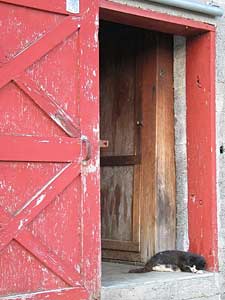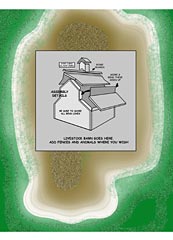
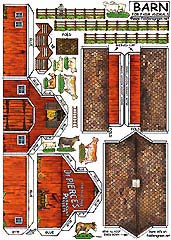
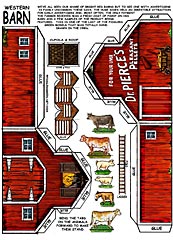
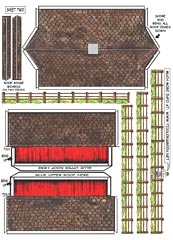
Barn-Livestock - $$3.95
The livestock barn is still seen on most farms. Upstairs, the loft was used for winter hay storage and with access doors at each end, went far to keep the downstairs cool in the summer. The cupola up on the roof always kept the air fresh and circulating. As you travel along the highways in the east, look hard and you'll still see old and peeling 'Mail Pouch' advertisements on some lucky barns. This one has an off-shoot for the small heard of milking cows. The main area is for equipment.
New England Painted
Livestock Barn

Watercolor of the Painted New England Barn by Derek Carter
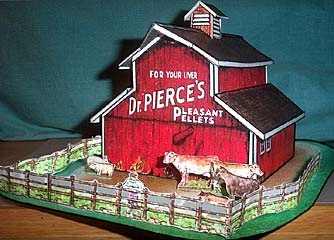 The average New England Barn had three
stalls for three teams of horses. The horse entered the open
stall from the back and walked up to the front of the stall
where he was tethered. A rope or a leather strap was anchored
to the manger at the front of the stall and was snapped onto
the halter. The manger, a wooden trough across the front of
the stall about four feet
high, was filled with hay. At each end of the manger, near the
top was a feed box. One for each horse. Each feed box was perhaps
three times the size of a shoe box and was used for feeding
grain.
The average New England Barn had three
stalls for three teams of horses. The horse entered the open
stall from the back and walked up to the front of the stall
where he was tethered. A rope or a leather strap was anchored
to the manger at the front of the stall and was snapped onto
the halter. The manger, a wooden trough across the front of
the stall about four feet
high, was filled with hay. At each end of the manger, near the
top was a feed box. One for each horse. Each feed box was perhaps
three times the size of a shoe box and was used for feeding
grain.
The teams were brought into the stalls and fed prior to going to the field. They were brushed and curried and all harness sores were treated with medication. Then they were harnessed, given a drink at the large water tank beneath the windmill, and hitched to the machine that was to be used for the day. This took place at about six o'clock in the morning and they would work until noon, when the horses would be returned for feed and water while the farmer ate his noon meal.
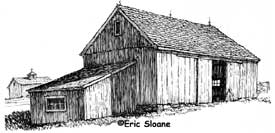 While
the 5 foot tall genetically engineered mutant sheep were a
concern, it's nothing you won't see at any agricultural school.
and the 5000 lb bossie just caused me to look for a bag of
kingsford, a book of matches and a steak knife. but the 60lb
chicken, now that scares me, them things are vicious...Spar
ky(9/01)
While
the 5 foot tall genetically engineered mutant sheep were a
concern, it's nothing you won't see at any agricultural school.
and the 5000 lb bossie just caused me to look for a bag of
kingsford, a book of matches and a steak knife. but the 60lb
chicken, now that scares me, them things are vicious...Spar
ky(9/01) Fall is, of course, the most popular time for photographers to invade this bucolic farm in the hopes of capturing its image on film. In the wintertime, the red-painted farm buildings are particularly attractive when framed in white. George Spontak, Vermont
Who first painted an advertising message on a barn? No one knows
for sure, but it's such a logical thing to do that it must have
happened early on, probably right after barns began to be enclosed
with planks over the original logs and sheet metal replaced shingle
roofs. Usually located close to roads and presenting large, flat
surfaces, barns were cheap and read-made billboards, which people
with something to sell could not have failed to notice. Some even
advertised themselves: On the plains of central Ohio, farmers of
150 years ago put their names on the great barns they built so the
world would know of their achievements.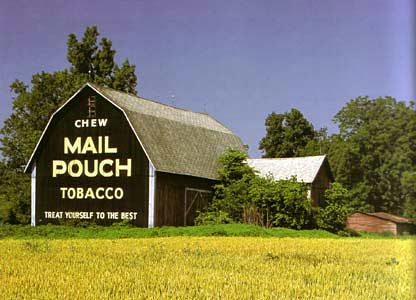
Whoever was first, it's generally agreed that the Block Brothers
Tobacco Company of Wheeling, West Virginia, was the first to set
up an organized, large-scale barn advertising program. Block Brothers
began painting its "Chew Mail Pouch Tobacco" slogan on
barns in 1897 and continued its campaign until 1993. Hundreds of
Mail Pouch barns still dot the Midwest. The only comparable advertising
campaign was waged by a tourist attraction named Rock City Gardens
near Chattanooga, Tennessee.
Surgeon General's Warning: Chewing tobacco can make your face rot off.
Although it involved fewer barns over a shorter span of time, the "See Rock City" program may have been even more influential. Probably the third most asked question by travelers through the South in the 1940s through the 1960s after "Are we almost there yet?" and "When do we eat?" was "What the heck is a rock city?" Driven beyond endurance by the pervasive message of the ubiquitous barns and the chorus of pleas from back seats, millions of tourists made the pilgrimage up Lookout Mountain to see for themselves what a rock city might be.
Mail
Pouch Barn
The sides of barns made ideal billboards along country roads in
the days before interstate highways. Bloch Brothers Tobacco Company
of Wheeling, WV, sparked the revolutionary idea, and its "Mail
Pouch Barns" became roadside icons. Bloch Brothers
began painting its Chew Mail Pouch Tobacco slogan
on barns in 1897 and continued its campaign until 1993. More than
20,000 barns from Ohio and Pennsylvania, through the Midwest and
as far a field as California and the Pacific Northwest were used
to sell the chaw. This barn stands by a wheat field near Bryan,
Ohio.
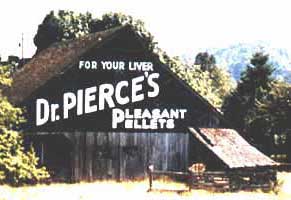 Many others have advertised on barns over the years, some of them
extensively, but Mail Pouch Tobacco and Rock
City were almost certainly the largest and best-known campaigns.
Ruby Falls, another tourist attraction near Chattanooga, currently
maintains a number of barns in Tennessee, and Meramec Caverns, an
attraction in Missouri, has barns throughout much of the Midwest
and as far away as eastern Kentucky. Mammoth Cave in Kentucky also
has some barn advertising. Jefferson Island Salt once advertised
heavily on barns, but their signs are fading out.
Many others have advertised on barns over the years, some of them
extensively, but Mail Pouch Tobacco and Rock
City were almost certainly the largest and best-known campaigns.
Ruby Falls, another tourist attraction near Chattanooga, currently
maintains a number of barns in Tennessee, and Meramec Caverns, an
attraction in Missouri, has barns throughout much of the Midwest
and as far away as eastern Kentucky. Mammoth Cave in Kentucky also
has some barn advertising. Jefferson Island Salt once advertised
heavily on barns, but their signs are fading out.
The stories of the Mail Pouch and Rock City barns are forever linked
to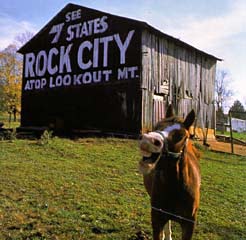 two men, one the first barn-advertisement painter and the other
the last. Clark By ers and Harley War rick were advertising men,
for sure, but not your basic gray-flannel-suit types. It's doubtful
either of them ever came within hog-calling distance of Madison
Avenue, yet this homespun duo were key players in two of the greatest
outdoor advertising campaigns of all time. Their work helped define
an era in American folk history.
two men, one the first barn-advertisement painter and the other
the last. Clark By ers and Harley War rick were advertising men,
for sure, but not your basic gray-flannel-suit types. It's doubtful
either of them ever came within hog-calling distance of Madison
Avenue, yet this homespun duo were key players in two of the greatest
outdoor advertising campaigns of all time. Their work helped define
an era in American folk history.
Barn Painting Ends:
The beginning of the end of the barn as a major advertising medium
cam in 1968, when the Highway Beautification Act of 1966 - the so-called
"Ladybird Law" took effect. Both Rock City and Mail Pouch
Tobacco were forced to cut their barn painting programs to the bone.
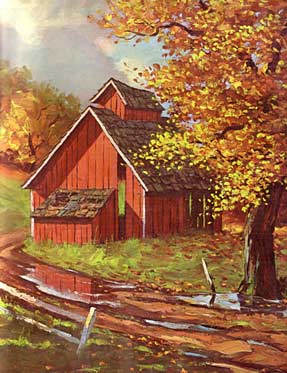 New England Barn after an Autumn Rain |
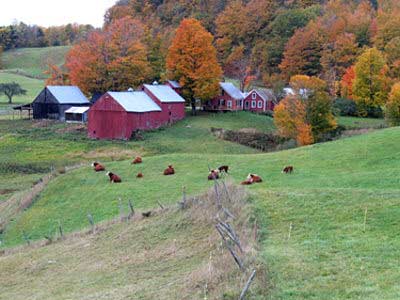 Jenne Farm in Vermont |
Directions to Jenne Farm... before leaving Woodstock, Vermont, on Route 106 South. From Woodstock, the farm is about a 15-minute drive. You'll want to keep your eyes out for Jenne Road on the right-hand side.
Jenne Farm has also graced magazine covers, appeared in a Budweiser commercial and served as a setting in movies such as Forrest Gump and Funny Farm. |
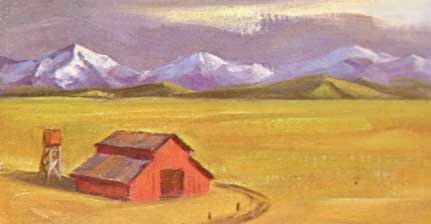 Barn in the High Country of Nevada |
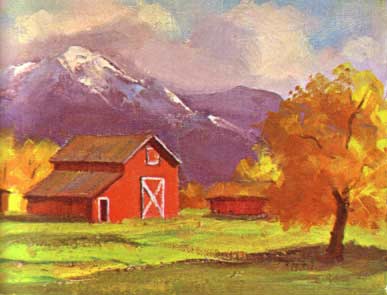 Barns and early snows in the mountains |
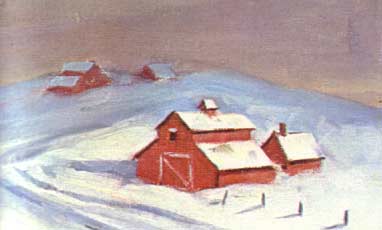 Wintering the New England Barns |
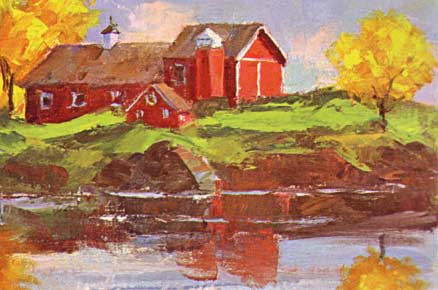 New England Barn by a Pond |
